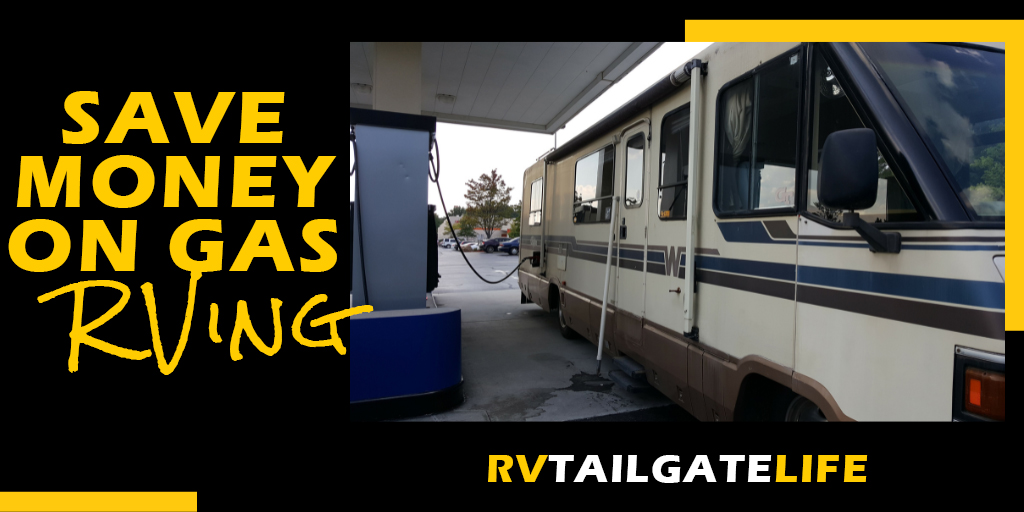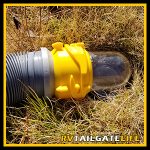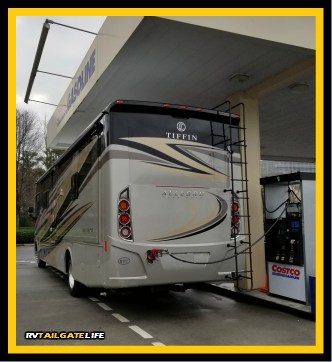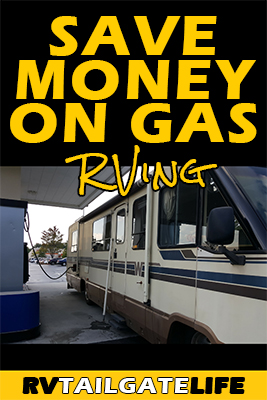How to Save Gas while RVing
Wow, oh wow, is gas expensive these days! And let’s not talk about the price of diesel.
The price of gas is now cringe-inducing when we even think about taking the RV out on a road trip or plan this fall’s tailgates.
But we can’t let the price of gas stop us from enjoying our RV! Let’s take a look at some of the ways that we can save money on gas while RVing, to take at least a little of the sting out of our wallets.

Disclosure: This post contains affiliate links for various products below. You get the same low prices and we earn a small commission.
Gas vs Diesel, which is better for RVing?
Way back in the beginning, when you were first buying your RV, you probably did an analysis on gas versus diesel RVs (or trucks).
Back then, the analysis may not have spent too much time on the various costs, but with the recent drastic increase in diesel, this is more important than ever!
Diesel typically gets about 10-15% more power than gasoline powered vehicles.
According to AAA, as of June 20, 2022, though, the average price of regular unleaded is $4.981 while the average price of diesel is $5.815. (And it is going to be more expensive out west than in the southeast.)
That takes away a lot of the benefits in the gas vs diesel debate, at least when it comes to saving gas money while RVing.
Honestly, I wouldn’t use the price of gas and diesel as a strong pro or con in the debate. And it definitely doesn’t make sense to change what type of RV you get based on current prices, since we don’t know what will happen going forward. I’m not going to trade in my RV at this point just based on the type of fuel it uses.
But there are other things that we can do to improve the efficiency of our RVs and thus get better mileage and save money!
Reduce Weight, Increase MPG
If you’ve heard it once, you’ve heard it a million times. Reduce the weight in your vehicle to increase your miles per gallon.
For cars and smaller vehicles, the standard metric is 100 pounds of weight reduced will increase your fuel economy by about 1%.
Of course, RVs, whether that is motorhomes or trucks towing fifth wheels and travel trailers, are a little different. We cannot expect the same gains in fuel efficiency. However, that doesn’t mean that you won’t get better MPG by reducing the weight of your RV.
Plus it is free! And you’ll probably better enjoy your RV without all the extra stuff taking up room in there.
So get to your spring cleaning and declutter that RV!
Travel with Your Water Tanks Empty
A gallon of water weights about 8.35 pounds.
If you have a large fresh water tank, that can be hundreds of pounds of weight that you are potentially unnecessarily carrying around, making your engines do more work and using more gas!
 That’s why many RVers will decide to travel with the water tanks empty, preferring to fill up at the campground or near their boondocking location.
That’s why many RVers will decide to travel with the water tanks empty, preferring to fill up at the campground or near their boondocking location.
And don’t forget about your black and gray tanks too!
You’ll want to travel with those mostly empty as well, to get the best gas mileage. It is useful, though, from a black and gray tank maintenance perspective to throw a few gallons of water in there along with your favorite black tank treatment to slosh around while you are driving. A few gallons won’t do as much damage to your MPG, not like a full tank will. And will provide a lot of benefits to clean everything out.
RV Maintenance is Important for RV Gas Mileage
Keeping on top of your RV maintenance is another great way to improve or maintain your RV gas mileage.
Clean air filters, oil in good condition, good tire pressure and tire alignment… all important aspects in keeping your RV in tip top shape and improving RV gas mileage.
Tire Pressure is Important
Do you monitor the tire pressure in your RV tires? If your tires have too low of pressure, it is going to take more effort for your RV, decreasing the efficiency and the power that your gas provides. Thus costing you more money.
You should always drive with properly inflated tires, but it is especially important when you are trying to save gas money. Get your RV weighed, determine and set the proper inflation, and then monitor the PSI as you travel with a Tire Pressure Monitoring System.
Plan Your Trips Closer to Home
We’ve got a lot of country to cover, but maybe right now, it is better to explore the areas closer to home.
Shorter trips means less fuel. And that means more cash in your pocket.
I know that personally, there are a lot of awesome camping spots in my state or within 2-3 hours of travel time that I still have to explore.
Stay Longer in One Place
Have you ever heard of slow travel? It’s not just the guy in the right lane.
Slow travel is the idea that you get one place and stay there longer, going deeper into what an area has. So if you have a long RV trip planned, spend more time in fewer places – traveling less often between trips. That will save you a ton of money on gas. Often, you can negotiate weekly or monthly discounts at RV campgrounds versus the more expensive daily rates! Double cash savings!
Is Boondocking Still the Answer?
Many of us LOVE boondocking – getting away from the hustle of city life. Or perhaps it’s an overnight RV parking spot on our way to our destinations.
In any case, getting away from the RV campgrounds and boondocking is often seen as an attractive way to save money. But if you are doing this in the south, you’ll want to run your air conditioner all night long. And that means burning gas.
At what point does it make sense to plan your trip with an overnight stay in a campground to save gas money?
See Also: A Guide to Common RV Abbreviations and Slang
RV Travel Day Considerations
You’ve done your maintenance, you’ve decluttered and reduced your RV weight and now it is time to hit the open road.
Let’s take a look at some of the things that we can do to save on fuel costs while RVing, based on what we do on our travel days.
To Air Condition or Not To Air Condition?
It’s no secret that air conditioning takes up a lot of power. It’s why most of us typically cannot get enough solar power to run the air conditioners, and instead have to rely on either hookups or our generators.
And well, our generators take fuel. Lots of it.
If it is possible, try traveling without air conditioning. Using no air conditioning can increase fuel efficiency by 5-25%, compared to using max air conditioning.
If you can’t do that (and well, I can’t, because I live and travel in the south!) then let’s try to reduce the use of air conditioning.
Can you get away using only your dash air? Or maybe one air conditioner instead of two or three?
In my RV, I have two air conditioners plus the dash air conditioning. But I can choose to cool only the front half, closing the bedroom sliding door. That decreases my air conditioning use by half, using only one of the two main units.
If the day is cloudy or the temperatures are not “surface of the sun” hot, I can sometimes get away with just using the dash air conditioning, thus not needing the main units at all. And that means that I don’t need the generator at all, which results in major fuel savings!
It may also make sense to drive in early morning hours or at night, to allow a more comfortable drive without the heavy AC use.
Cruise Control and Steady Speeds
Another good way to save on fuel during your travels is to set a lower speed and maintain that speed.
Most of our RVs and trucks are going to have a sweet spot around 63 mph for the best mpg on the highway. Going faster than this is going to reduce your MPG and cost you more money.
Once you get up to speed, maintaining this speed is going to be a lot more efficient than speeding up and slowing down all the time.
And yes, I totally understand that this may be a “do as I say, not as I do” kind of thing. I totally admit, it’s hard for me to stay in the slow lane. But it is definitely better for fuel costs.
Avoid Idling and Traffic James
We can often plan our trips to avoid rush hours and predictable traffic jams. That doesn’t mean that we always can avoid those unexpected traffic jams due to construction or accidents.
Sitting idle is going to destroy your MPG and cost you money. So when possible, try to plan your trips to arrive at your destination before rush hour. Or use that time to stop and eat dinner, avoiding the worst of the traffic.
Use Waze to check current traffic conditions, but be careful about using the alternative routes that may be suggested. Waze uses car dimensions that may not be safe for the taller and longer RVs. So check those routes against your RV-approved GPS system.
Avoid Heavy Winds and Bad Weather
You’ll want to avoid traveling with heavy winds or bad weather. It’s a safety first kind of thing, but it also affects your fuel efficiency.
Traveling into the wind is going to take a lot of effort. So unless you are truly going west to east and with the winds, it’s likely that you’ll either be traveling against the wind or cross-winds will be hitting your RV. And don’t forget about those windy roads, where sometimes you wouldn’t have those tailwinds.
Fuel Discount Clubs and Saving Money on Purchases
Notice that I saved the fuel discount clubs until last? That wasn’t on accident. It is my preference to do all the other things first and then get to the stuff that will cost you more money.
Often, the fuel discount clubs/cards cost you money. So you’ll need to figure out if they are really worth it.
GetUpside
Have you heard of the Upside app that lets you save on gas? It’s great for finding and then saving on gas when you are away from home.
It’s a free app, available on both Apple and Android devices that let you see the current prices and how much you’ll save on each gallon.
When you claim the offer, you’ll get the savings deposited into your Upside account which you can then cash out later.
Good news – it is not just gas. You can also save on restaurants and groceries too! This is a great way to find restaurants in areas that you are not familiar with. And save money too.
Use GetUpside on your next RV fillup and save an extra 15 cents per gallon with referral code 8NVVBH.
Costco Clubs
 One of my favorite places is Costco. (They have some great tailgating chairs, too)
One of my favorite places is Costco. (They have some great tailgating chairs, too)
The Costco gas stations are typically pretty RV friendly – long hoses, high canopies, etc. The biggest problem will often be their parking lots. They are busy and designed for cars, not large RVs that might be towing cars.
The basic Costco membership is $60 and that’s good for two people in the same household.
Currently, Costco has regular unleaded at about 20 cents cheaper than the surrounding gas stations near me. It’s going to take me 300 gallons of fuel to break-even on that membership or about 4-5 tanks of gas. It’s usually worth it for me, since I have a Costco near my house that I can use – not just for the RV gas, but also my personal vehicle.
They have a liquor store on-site which is great to stock-up the basic bar at the beginning of tailgate season. I also use Costco for wine and beer, tailgate supplies, and yes, their toilet paper. The Kirkland brand toilet paper is septic tank safe and is generally safe to use in the RV black tanks.
Good Sam Club
Want an automatic 5 cents off gas or 8 cents of diesel at Pilot and Flying J locations across the country? Then Good Sam
is the discount club for you.
Currently, the base membership is $29/year. At 5 cents a gallon for my Class A gas RV, that’s about 580 gallons that I need to break-even on my membership on just the gas savings. About 5,000 miles of travel, not including generator time.
But in addition to the gas savings, the retail discounts and free shipping from Camping World and Gander RV and discounts at many RV campgrounds come in real nice.
Join for multiple years and you’ll also get merchandise credits at Camping World or Gander RV. Which makes it an even better deal!
Save Gas While RVing
 We know gas is expensive. But following these tips and then joining the various clubs and cards for discounts will save gas money while RVing.
We know gas is expensive. But following these tips and then joining the various clubs and cards for discounts will save gas money while RVing.
Like these tips to save gas while RVing? Pin for later!
You May Also Like:
RV Insurance Explained Before You Shop
How To Stream Live Sporting Events in the RV
Tips for Renting an RV for Tailgating
